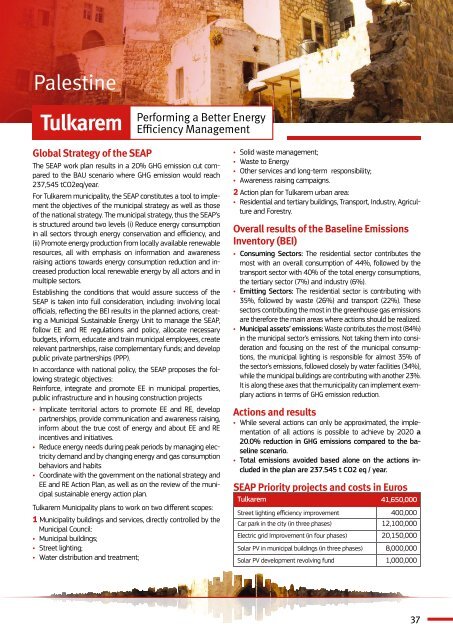CES-MED Publication EN-final 2018-WEB
Create successful ePaper yourself
Turn your PDF publications into a flip-book with our unique Google optimized e-Paper software.
Palestine<br />
Tulkarem<br />
Performing a Better Energy<br />
Efficiency Management<br />
Global Strategy of the SEAP<br />
The SEAP work plan results in a 20% GHG emission cut compared<br />
to the BAU scenario where GHG emission would reach<br />
237,545 tCO2eq/year.<br />
For Tulkarem municipality, the SEAP constitutes a tool to implement<br />
the objectives of the municipal strategy as well as those<br />
of the national strategy. The municipal strategy, thus the SEAP’s<br />
is structured around two levels (i) Reduce energy consumption<br />
in all sectors through energy conservation and efficiency, and<br />
(ii) Promote energy production from locally available renewable<br />
resources, all with emphasis on information and awareness<br />
raising actions towards energy consumption reduction and increased<br />
production local renewable energy by all actors and in<br />
multiple sectors.<br />
Establishing the conditions that would assure success of the<br />
SEAP is taken into full consideration, including: involving local<br />
officials, reflecting the BEI results in the planned actions, creating<br />
a Municipal Sustainable Energy Unit to manage the SEAP,<br />
follow EE and RE regulations and policy, allocate necessary<br />
budgets, inform, educate and train municipal employees, create<br />
relevant partnerships, raise complementary funds; and develop<br />
public private partnerships (PPP).<br />
In accordance with national policy, the SEAP proposes the following<br />
strategic objectives:<br />
Reinforce, integrate and promote EE in municipal properties,<br />
public infrastructure and in housing construction projects<br />
• Implicate territorial actors to promote EE and RE, develop<br />
partnerships, provide communication and awareness raising,<br />
inform about the true cost of energy and about EE and RE<br />
incentives and initiatives.<br />
• Reduce energy needs during peak periods by managing electricity<br />
demand and by changing energy and gas consumption<br />
behaviors and habits<br />
• Coordinate with the government on the national strategy and<br />
EE and RE Action Plan, as well as on the review of the municipal<br />
sustainable energy action plan.<br />
• Solid waste management;<br />
• Waste to Energy<br />
• Other services and long-term responsibility;<br />
• Awareness raising campaigns.<br />
2 Action plan for Tulkarem urban area:<br />
• Residential and tertiary buildings, Transport, Industry, Agriculture<br />
and Forestry.<br />
Overall results of the Baseline Emissions<br />
Inventory (BEI)<br />
• Consuming Sectors: The residential sector contributes the<br />
most with an overall consumption of 44%, followed by the<br />
transport sector with 40% of the total energy consumptions,<br />
the tertiary sector (7%) and industry (6%).<br />
• Emitting Sectors: The residential sector is contributing with<br />
35%, followed by waste (26%) and transport (22%). These<br />
sectors contributing the most in the greenhouse gas emissions<br />
are therefore the main areas where actions should be realized.<br />
• Municipal assets’ emissions: Waste contributes the most (84%)<br />
in the municipal sector’s emissions. Not taking them into consideration<br />
and focusing on the rest of the municipal consumptions,<br />
the municipal lighting is responsible for almost 35% of<br />
the sector’s emissions, followed closely by water facilities (34%),<br />
while the municipal buildings are contributing with another 23%.<br />
It is along these axes that the municipality can implement exemplary<br />
actions in terms of GHG emission reduction.<br />
Actions and results<br />
• While several actions can only be approximated, the implementation<br />
of all actions is possible to achieve by 2020 a<br />
20.0% reduction in GHG emissions compared to the baseline<br />
scenario.<br />
• Total emissions avoided based alone on the actions included<br />
in the plan are 237.545 t CO2 eq / year.<br />
SEAP Priority projects and costs in Euros<br />
Tulkarem Municipality plans to work on two different scopes:<br />
1 Municipality buildings and services, directly controlled by the<br />
Municipal Council:<br />
• Municipal buildings;<br />
• Street lighting;<br />
• Water distribution and treatment;<br />
37
















